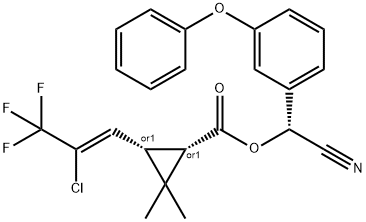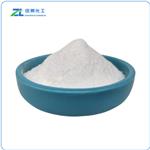Description
Cyhalothrin is a broad-spectrum pesticide and acaricide that is used to control a wide range of pests in a variety of applications. It belongs to the pyrethroid, a class of synthetic insecticides which has the similar structure and insecticidal activity of the naturally occurring insecticide pyrethrum, derived from the flowers of chrysanthemums. It is commercially used for controlling insects on non-food crops, greenhouses, hospitals, and crops, such as cotton, cereals, hops, ornamentals, potatoes, vegetables, etc. and it targets various kinds of pests, including aphids, Colorado beetles and butterfly larvae. Besides, it is effective to used in public health applications to control insects identified as potential disease vectors, such as cockroaches, mosquitoes, ticks, and flies.
Registered with the EPA in 1988, Cyhalothrin is often preferred as an active ingredient in insecticides because it is proved to be mostly insoluble in water, which is an unlikely water contaminant. It is also nonvolatile, which makes it remain effective for extended periods of time.
References
https://en.wikipedia.org/wiki/Cyhalothrin
http://pmep.cce.cornell.edu/profiles/extoxnet/haloxyfop-methylparathion/lambda-cyhalothrin-ext.html
http://www.toxipedia.org/display/toxipedia/Lambda-Cyhalothrin
Chemical Properties
olorless to beige powder; or viscous
yellowish-brown liquid. Mild odor. Liquid formulations
containing organic solvents may be flammable.
Uses
Insecticide; pyrethrin analog
Definition
ChEBI: (1S)-cis-(alphaR)-cyhalothrin is a cyclopropanecarboxylate ester.
Agricultural Uses
Insecticide; acaridide: A U.S. EPA restricted Use Pesticide (RUP). Only cyhalothrin is banned for use in EU; not lamda-isomer; CAS 68085-85-8). Used to control a variety of pests in many crops. Also used in structural pest situations..
Trade name
CHARGE®; COMMODORE®; DEMAND®; DEMAND CS®; DOUBLE BARREL®; EXCALIBER®; GRENADE®; HALLMARK®; ICON®; IMPASSE®; KARATE®; MATADOR®; NINJA®; PP321®; RATE®; SABER®; SAMURAI®; SCIMITAR®; SENTINEL®; WARRIOR®
Potential Exposure
Pyrethroid insecticide and acaridide
used to control a variety of pests in many crops. Also used
in structural pest situations. A United States Environmental
Protection Agency Restricted Use Pesticide (RUP). Only
cyhalothrin is banned for use in EU; not the lamda-isomer
(CAS 68085-85-8).
Metabolic pathway
The solution and solid-phase photodecomposition of
cyhalothrin involves E/Z and cis/trans isomerization
reactions and frees radical processes leading to
decarboxylation, ester cleavage, proton abstraction,
oxygen scavenging, and reactions with solvent-
generated radicals. The major degradation products
are decarboxylated analogs which are also
isomerized at the cyclopropyl and vinyl groups. In
vitro incubation of 14C-cyhalothrin with honey bee
mid-guts yields the principal metabolite identified as
4-hydroxy-3-phenoxybenzyl alcohol with a small
amount of 3-phenoxybenzoic acid. In vivo metabolism
with honey bees shows the major metabolites 4'-hydroxy-and 2'-hydroxy-3-phenoxybenzyl alcohols
and 4'-hydroxy-3-phenoxybenzoic acid. Prochloraz
delays the metabolism, detoxication, and excretion of
cyhalothrin by inhibition of microsomal oxidation,
effectively enhancing the toxicity to the honey bee.
Shipping
UN3349 Pyrethroid pesticide, solid
toxic, Hazard Class: 6.1; Labels: 6.1-Poisonous material.
UN3082 Environmentally hazardous substances, liquid,
n.o.s., Hazard class: 9; Labels: 9-Miscellaneous hazardous
material, Technical Name Required.br UN3077 Environmentally hazardous substances, solid,
n.o.s., Hazard class: 9; Labels: 9-Miscellaneous hazardous
material, Technical Name Required.
Incompatibilities
May react violently with strong oxidi-
zers, bromine, 90% hydrogen peroxide, phosphorus
trichloride, silver powders, or dust. Incompatible with silver
compounds. Mixture with some silver compounds forms
explosive salts of silver oxalate. Hydrolyzed by water
Waste Disposal
Incineration would be an
effective disposal procedure where permitted. If an efficient
incinerator is not available, the product should be mixed
with large amounts of combustible material and contact
with the smoke should be avoided. In accordance with
40CFR165, follow recommendations for the disposal of
pesticides and pesticide containers.





